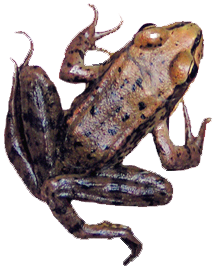This year masks and social distancing added another layer of strangeness to our walking along dark roads in the rain, catching frogs. The 2019-20 winter frog season was cut short in March as the pandemic ramped up and Oregon Fish and Wildlife told us to cease and desist. For the 2020-21 season we worked out a pandemic frog-catching protocol to keep us safe, but for unknown reasons, the Northern red-legged frogs simply didn’t appear in the numbers we’ve seen in past years. The weather has been normal for the Pacific Northwest; very wet, with moderate temperatures, but even on nights with perfect conditions (raining and 48-50 degrees), the frogs mostly haven’t shown. We’ve caught only 271 females going down to the wetland, and an even more paltry 139 males, about half the numbers we’ve come to expect over these past eight years. So when PGE, the local electrical company and owners of the wetland, counted 435 egg masses in February, it was a big, pleasing surprise. (Doubling the number of egg masses gives us a rough estimate of total frogs. We’ve had a slow progression in numbers over the years, transporting between 600 and 2000 frogs to and from the wetland.)
This year the number of frogs returning to the forest from the wetland was even more measly, accompanied by a rising suspicion of what was going on. Only 147 females were caught and transported from the wetland up to the forest edge, and just 28 males. (The males hang out longer in the wetland for more breeding opportunities, which may explain this discrepancy.) After the first two or three years of doing this frog taxi we noticed the frogs were trying to flank us; coming out of the forest to the north and south of their usual place of emergence near Harborton Creek, avoiding the Cyclops monsters with the bucket prisons (us), who pace the dark edge of Harborton Road like zombies. If the frogs could change their migration route to avoid us, might they change the time of night? Then on April 6 -- late in the season -- Ashley Sorenson, a frog volunteer, arrived at the airport on a late flight and, curious about the frogs, instead of going home, drove by Harborton at 3:30 in the morning. There was very little highway traffic, the temperature was about 43, and it was raining hard. There were quite a few frogs on the highway, more than a dozen! Ashley didn’t hang around to see the extent of the movement.
We’ve known for a while that frogs may migrate at any time on a winter night, when the conditions are right, and that they migrate in dribs and drabs, as we’ve caught one frog, 11, or 56 on any given night. But the really big migrations -- hundreds or perhaps thousands, in a truly healthy habitat -- are wild, frog floods beginning around dusk. If the frogs are delaying the big numbers till later in the night to avoid us, that would be news, and an impressive development. Simply flanking us is a considerably less abstract strategy than waiting to migrate hours after we’ve left. Since we haven’t seen the sort of mass migration that’s the norm this year, the frogs may be changing a migration habit that could easily go back tens of thousands of years, if not much longer, an adjustment accomplished by animals who live a solitary existence most of the year. For them to make a major change in habit -- collectively, and relatively quickly -- would be impressive.
Of course it will likely be some time, and take a lot more observation, before we know if this population of frogs is changing its migration pattern, and what proportion of the population is changing. It’s an exciting possibility that we’ll get to see evolution in action; an important behavioral adaptation for survival happening in practically the blink of an eye. The highway traffic has thinned considerably during the pandemic, though now that the towns to the north are bedroom communities of Portland, and continue to grow, the traffic will certainly worsen, especially when the migration of climate change refugees ramps up, drought and intense heat creating competing migrations, an unfair fight for the frogs. Hopefully, before then we’ll have built a series of tunnels under the highway to connect frogs, salamanders, and newts to their riparian wetlands, even if they’ve learned to change their migration pattern to the middle of the night. The pressure of human migration from the south will apply ever more pressure on wildlife, so we need to prepare now, with this sort of habitat connectivity being part of overall strategy to address climate change and the ongoing degradation of the planet.
Photo by Avery Marvin Long-toed Salamander, Ambystoma macrodactylum, another forest dweller who migrants to the wetland to breed.

